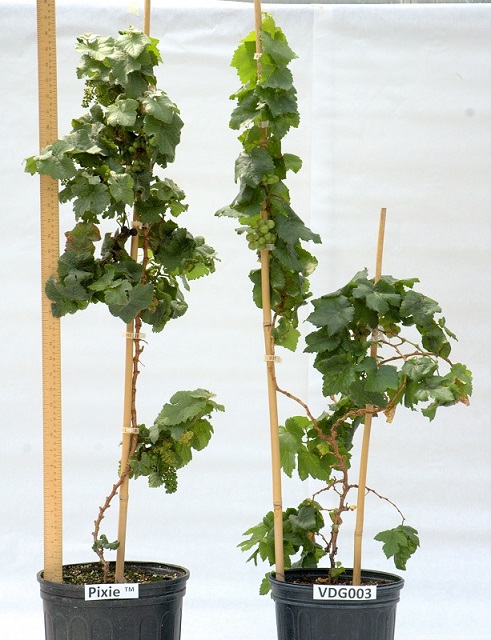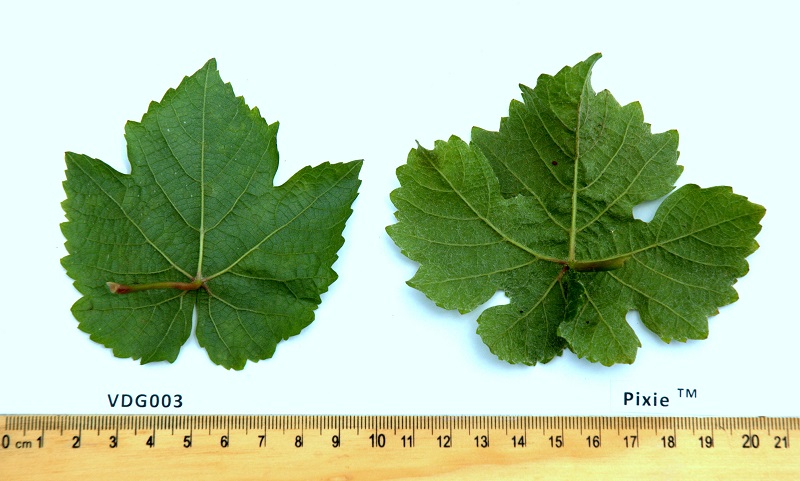VDG003
| Denomination: | 'VDG003' |
|---|---|
| Previously Proposed Denomination: | 'PxREN1.003' |
| Botanical Name: | Vitis vinifera |
| Applicant/Holder: |
Vineland Research and Innovation Centre 4890 Victoria Avenue North P.O. Box 4000 Vineland Station, Ontario L0R 2E0 Canada |
| Breeder: |
Daryl Somers, Fenwick, Ontario Rumen Conev, St. Catharines, Ontario |
| Application Date: | 2013-06-06(priority claimed) |
| Application Number: | 13-8054 |
| Protective direction granted: | 2013-06-06 |
| Protective direction withdrawn: | 2014-04-17 |
| Grant of Rights Date: | 2016-02-03 |
| Certificate Number: | 5176 |
| Date rights surrendered: | 2017-03-29 |
Variety Description
Variety used for comparison: 'Pixie'
Summary: The prostrate hairs on the tip of the young shoot of 'VDG003' are of sparse to medium density while the prostrate hairs of 'Pixie' are very dense. The prostrate hairs between the veins on the lower side of the young leaf blade of 'VDG003' are absent or very sparse whereas the prostrate hairs of 'Pixie' are very dense. The colour of the upper side of the young leaf blade of 'VDG003' is lighter brown green than the leaf blade of 'Pixie'. The colour on the dorsal and ventral side of the node and internode on the shoot of 'VDG003' is green and red whereas it is only green for 'Pixie'. The shoot of 'VDG003' has very few tendrils whereas the shoot of 'Pixie' has none. The mature leaf blade of 'VDG003' is circular in shape with three lobes whereas the leaf blade of 'Pixie' is pentagonal in shape with five lobes. The upper side of the mature leaf blade of 'VDG003' has a weak to medium degree of blistering whereas the leaf blade of 'Pixie' has strong blistering. The upper lateral sinuses of the mature leaf blade of 'VDG003' are shallow whereas the sinuses of 'Pixie' are medium to deep. The teeth along the margin of the mature leaf blade of 'VDG003' are shaped with both sides convex whereas the teeth of 'Pixie' are shaped with a mixture of both sides straight and both sides convex. The plants of 'VDG003' produce more lax bunches of berries than the plants of 'Pixie'. The colour of the skin of the berry is green brown for 'VDG003' whereas the skin of 'Pixie' is black. The berry of 'VDG003' has no particular flavour whereas the berry of 'Pixie' has an herbaceous flavour. The plants of 'VDG003' carry the REN1 gene for resistance to powdery mildew (Erysiphe necator) whereas the plants of 'Pixie' do not.
Description:
YOUNG SHOOT TIP: closed, sparse to medium density of prostrate hairs, absent or very weak intensity of anthocyanin colouration of prostrate hairs, absent or very sparse erect hairs
SHOOT TENDRIL: very few
SHOOT INTERNODE: green dorsal and ventral side
SHOOT NODE: green dorsal and ventral side
WOODY SHOOT: light brown (RHS 174C)
FLOWER: fully developed stamens and fully developed gynoecium
YOUNG LEAF BLADE: upper side is brown green (RHS N137C), absent or very sparse prostrate hairs between main veins on lower side
MATURE LEAF BLADE: very small to small, circular shape, weak to medium degree of blistering of upper side, three lobes, shallow upper lateral sinuses, arrangement of lobes of upper lateral sinuses is not touching, arrangement of lobes of petiole sinus is slightly overlapping, proportion of main veins on upper side with anthocyanin colouration is absent or very low, absent or very sparse prostrate hairs between main veins on lower side, absent or very sparse erect hairs on main veins on lower side, length of petiole is much shorter than length of middle vein
TEETH ALONG MARGIN OF MATURE LEAF BLADE: short, short length in relation to width, shape is both sides convex
BERRY BUNCH: very small, medium density, peduncle of primary bunch is medium to long
BERRY: small to medium size, globose shape, moderately easy to detach from pedicel, no particular flavour, seed formation is complete
BERRY SKIN: green brown (RHS 153B), medium thickness
BERRY FLESH: moderately firm, absent or very weak intensity of anthocyanin colouration
DISEASE RESISTANCE: contains powdery mildew (Erysiphe necator) resistance gene REN1
Origin & Breeding History: 'VDG003' (experimental designation 'PxREN1.003') originated from a controlled hybridization between the dwarf variety 'Pixie', as the female parent, and variety 'Kishmish Vatkana', as the male parent. The original cross was conducted at the Vineland Research and Innovations Centre in Vineland Station, Ontario on November 22, 2010. 'VDG003' was selected on May 7, 2012 for its dwarfism, true hybridity, attractive ornamental display, and confirmed possession of the powdery mildew (Erysiphe necator) resistance gene REN1.
Tests & Trials: The comparative trial of 'VDG003' was conducted in a greenhouse during 2013 at the Vineland Research and Innovations Centre in Vineland Station, Ontario. There were 10 plants each of the candidate and reference variety grown on their own roots. Each plant was obtained from single node soft stem cuttings taken in 2012, rooted and planted into black, plastic, 25 cm diameter pots. This dwarf grape variety has indeterminant growth when grown under greenhouse conditions; therefore, seasonal growth characteristics were not assessed. All colour determinations were made using the 2007 Royal Horticultural Society (RHS) Colour Chart.
Comparison table for 'VDG003' with reference variety 'Pixie'
Colour of berry skin (RHS)
| 'VDG003' | 'Pixie' | |
|---|---|---|
| outer side | 153B | N186A |
Click on image for larger view

Grapevine: 'VDG003' (right) with reference variety 'Pixie' (left)
Click on image for larger view

Grapevine: 'VDG003' (left) with reference variety 'Pixie' (right)
Click on image for larger view

Grapevine: 'VDG003' (left) with reference variety 'Pixie' (right)
- Date modified: